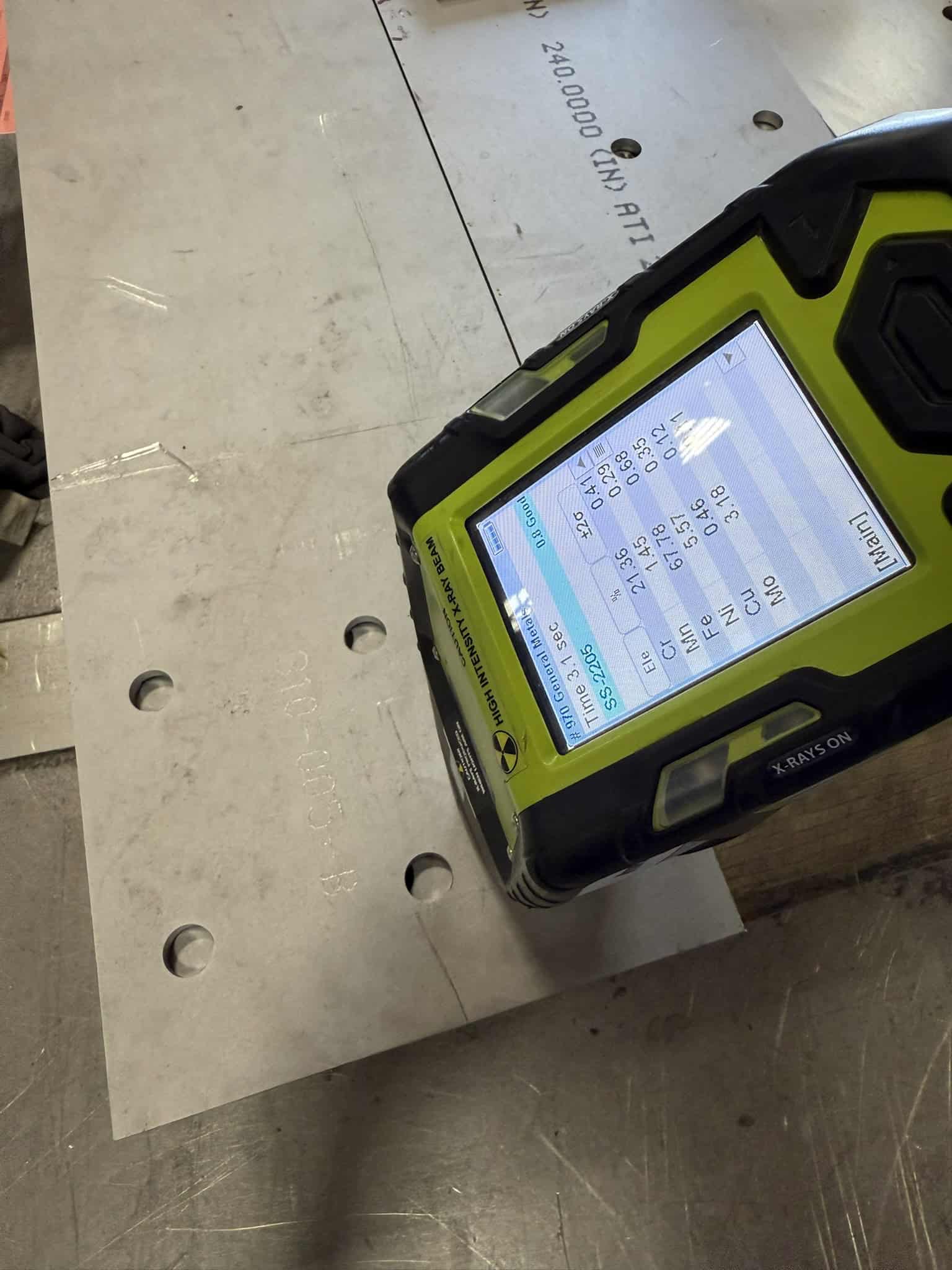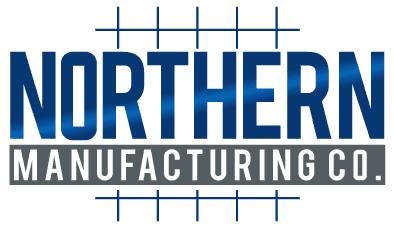The Risk of MTRs: A Guide to Material Traceability & PMI

| Northern ManufacturingProposed Meta Description: Discover the hidden risks in your stainless steel supply chain. Learn why Mill Test Reports (MTRs) aren’t enough and how Northern Manufacturing’s system of digital traceability and PMI verification ensures material integrity for critical components.
The Hidden Risk in Your Stainless Steel Supply Chain: A Deep Dive into Material Traceability, MTRs, and PMI Verification
Abstract
In the fabrication of mission-critical stainless steel components, the integrity of the raw material is the bedrock upon which all subsequent quality, reliability, and safety are built. While the supply chain for specialty alloys has become increasingly global and complex, the systems used to guarantee material integrity have often failed to keep pace, creating hidden risks that can lead to catastrophic failures. For Quality Assurance Managers, Procurement Specialists, and Reliability Engineers, understanding and mitigating these risks is a fundamental responsibility for ensuring operational safety, long-term asset performance, and corporate viability.
This report provides an in-depth analysis of the modern stainless steel supply chain, exposing the inherent limitations of traditional, document-based assurance methods. It establishes that over-reliance on the Mill Test Report (MTR) as a singular guarantee of quality is a flawed and high-risk strategy. The MTR, while essential, is a “paper tiger”—a document that provides the illusion of security without the substance, as it cannot account for supply chain errors or human error.
The gold standard for material assurance is a comprehensive, integrated framework: the Documentation-Traceability-Verification triad. This report deconstructs each component through the lens of Northern Manufacturing’s proven, ISO 9001:2015 certified approach:
Documentation (The MTR): Understanding the MTR’s data, its purpose, and, most critically, its inherent weaknesses.
Traceability (The Digital Chain of Custody): Implementing a disciplined, unbroken, and digitally-managed chain of custody that physically links a specific piece of steel back to its source documentation from receiving to final installation.
Verification (Positive Material Identification – PMI): Employing non-destructive testing at critical control points to provide empirical, scientific confirmation that the material in hand matches the specifications on paper.
Through an examination of the stringent regulatory landscapes in critical sectors and an analysis of industrial accidents linked to material failures, this report demonstrates the cascading consequences of a breakdown in this triad. The analysis concludes that a fabricator’s investment in a transparent, disciplined, and verifiable material integrity system is the most reliable indicator of their commitment to quality and their value as a strategic partner in risk mitigation.
1. Introduction: The “Paper Tiger” Problem
The Mill Test Report (MTR) is the foundational document in the material supply chain, serving as a material’s “birth certificate.” It provides the essential chemical and mechanical properties of the alloy, as certified by the mill. However, treating this document as an infallible guarantee is a critical misstep in risk management.
The core problem is that the MTR is a claim about a piece of paper, not a guarantee about the physical steel sitting on your shop floor. A breakdown can occur anywhere in the complex chain between the mill and the welder. Relying solely on documentation is an acceptance of unverified risk from the supply chain—a risk that can introduce catastrophic warranty and reputational damage into your finished product.
This paper will explore the principles of a robust material assurance program that moves beyond documentation alone. It will demonstrate how an integrated system of digital traceability and pragmatic PMI verification transforms risk into certainty, ensuring that the final product is not just built correctly, but built from the correct material, every time.
2. The Problem Statement: Why the Mill Test Report Is Not Enough
A diligent MTR review is a critical first step. It involves physically matching the Heat Number on the material to the document and cross-referencing the reported values against the required standards (e.g., ASTM, ASME). This process confirms that the paperwork is correct. It does not confirm that the physical material matches the paperwork. This gap exposes an organization to significant risks.
2.1. The Inherent Risk of Supply Chain Fallibility
Even with a perfectly accurate and non-fraudulent MTR, the global supply chain is vulnerable to human error. Material can be mislabeled at the mill, packaged incorrectly by a distributor, or mixed up during transit. Once an error is introduced, every document associated with that material becomes a source of misinformation.
Case in Point: A Critical Weld Wire Mix-Up
At Northern Manufacturing, our quality protocol includes routine PMI verification of incoming materials. During a check of welding consumables, a fillet weld on a project specifying Grade 316L stainless steel was tested. The PMI analyzer immediately flagged the weld material as an incorrect alloy, closer to Grade 308.
The welder, when questioned, showed the auditor the spool of wire in his machine, which was clearly and correctly labeled “316L.” The spool’s label matched the packing slip, the purchase order, and the certified MTR on file, which attested to its 316L chemistry. On paper, everything was perfect.
However, when we used the PMI analyzer on the physical wire itself, it confirmed the material was, in fact, 308. A mistake had been made somewhere in the supply chain, and an incorrectly constituted wire was packaged in a 316L-labeled spool.
This incident is a stark illustration of the MTR’s fundamental limitation. No amount of paperwork review could have caught this error. Without the physical verification step, a component with substandard corrosion resistance would have been shipped to the customer, creating a critical warranty risk and a latent failure in their system. This is why we operate on a “trust, but verify” principle, where PMI is not optional, but essential.
3. Principles & Outcomes: The Northern Manufacturing Material Integrity System
To counter the risks inherent in documentation, we have built our quality system on the interconnected principles of digital traceability and empirical verification. This system is designed to create an unbreakable and auditable link between the certified properties of a material and the final fabricated component.
3.1. Principle 1: Digital Traceability – An Unbroken Chain of Custody
The Heat Number is the unique DNA of a material, linking it to its MTR. Our
ISO 9001:2015 certified system ensures this link is maintained throughout the fabrication process. Traditional methods of manual Heat Number transfer are dangerously prone to human error. A single missed transfer creates an untraceable “orphan” component with no verifiable properties.
Our Embodiment: A Digitally-Managed System
Northern Manufacturing has eliminated these risks by moving beyond manual processes. Our approach codifies traceability within our digital manufacturing ecosystem:
Digital Twinning at Receiving: When material arrives, each lot receives a unique internal ID tag and barcode. This tag creates a permanent digital link between the physical material, the purchase order, and its corresponding MTR, which is scanned and attached electronically.
System-Driven Association: When a job is initiated, the material’s barcode is scanned, and our ERP system automatically associates that specific material lot—and its entire documented history—with the work order.
Flow-Down Traceability: This digital link follows the components through every stage of fabrication, from laser cutting to welding to finishing. There is no manual transfer of numbers to forget or misread.
The Outcome: Certainty and Auditability
This digital methodology provides absolute certainty. For any finished component, we can instantly produce a complete genealogy report that traces it back to the exact heat of steel it was made from and its original MTR. It provides an unimpeachable quality record essential for regulatory compliance and long-term asset management.
3.2. Principle 2: Pragmatic Verification – The PMI Backstop
Positive Material Identification (PMI) is the scientific process of analyzing an alloy to verify its chemical composition. It is the final and most critical leg of the quality triad, answering the question: “Is the material in my hand
actually what the paperwork says it is?”
Our Embodiment: Strategic PMI at Critical Control Points
Our program, overseen by on-staff ASNT SNT-TC-1A Level III personnel, uses PMI as a strategic tool to mitigate risk:
A Firewall at Receiving: All incoming raw materials are subject to PMI verification using handheld X-Ray Fluorescence (XRF) analyzers like our Niton XL2 GOLDD. This acts as a firewall, ensuring a supplier error is caught before the material ever enters our inventory system.
Consumable Confirmation: As our case study demonstrates, weld wire and other consumables carry the same supply chain risks. Verifying these materials, a process overseen by our
on-staff Certified Welding Inspectors (CWI), is a critical control point to ensure the finished weld seam meets specifications.
The Outcome: Proactive Error Prevention and Risk Mitigation
By deploying PMI at the front end of our process, we prevent material mix-ups from causing costly rework and schedule delays downstream. For our customers, this system provides the ultimate assurance. It proves we have not only tracked their material’s documentation but have empirically verified its chemical identity.
4. The Ripple Effect of Failure: Assessing the True Cost of a Material Mix-Up
When a component fails due to a material integrity issue, the direct cost of replacement is often the smallest part of the total financial impact. A proactive investment in a robust material assurance program must be weighed against the cascading consequences of a single failure.
4.1. The High Cost of Warranty Claims and Reputational DamageMost of our customers are OEMs selling products to their own end-users. If a component we build fails, the warranty claim is made against our customer. This triggers costly events: direct warranty costs, operational disruption for the end-user, and lasting reputational damage. Our material integrity system is a shield designed to protect our customers from these exact risks.
4.2. The Legal and Liability Minefield
A material failure that causes injury or property damage inevitably leads to legal action. A fabricator can be held liable for a failure caused by defective material received from a mill. Our robust, documented PMI verification program serves as a powerful defense. It demonstrates that we exercised due diligence, breaking the chain of inherited risk from the supply chain and insulating our company and our customers.
5. Conclusion: A Partnership in Risk Mitigation
Since 1951, Northern Manufacturing has understood that the integrity of a fabricated component is forged at every step of a disciplined process. Relying on documentation alone is an acceptance of unquantified risk. The
Documentation-Traceability-Verification triad is the only reliable path to certainty.
When selecting a custom fabricator, the engagement is a strategic partnership in risk mitigation. Your fabricator’s quality systems directly impact your operational reliability, brand reputation, and financial exposure.
The most reliable indicator of a partner’s value is their investment in a comprehensive and auditable material integrity system. A partner who can demonstrate a disciplined process for digital traceability, who can articulate a pragmatic strategy for deploying PMI, and who provides a complete, verifiable data package is not just a supplier. They are a strategic asset dedicated to protecting your customers, your reputation, and your long-term success.
To elevate the scrutiny of your supply chain, you must go beyond the certificate. Audit the process. Demand verification. In doing so, you are not just buying steel; you are buying certainty.
Ready to de-risk your supply chain? Discuss your next critical fabrication project with a Northern Manufacturing technical expert.
Discuss Your Fabrication Challenge with Our Engineering Team
Partner with a fabricator that protects your investment. Submit your drawings to our team for a technical review and a comprehensive quote that reflects the true cost of quality.
